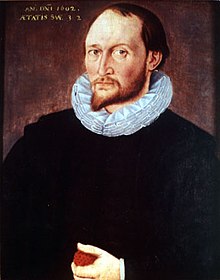Thomas Harriot | |
|---|---|
 Portrait often claimed to be Thomas Harriot (1602), which hangs in Trinity College, Oxford. The provenance of this portrait is not known, and there is little evidence to link it to Harriot.[1] | |
| Born | c. 1560 Oxford, England |
| Died | 2 July 1621 (aged 60–61) London, England |
| Alma mater | St Mary Hall, Oxford |
| Scientific career | |
| Fields | Astronomy, mathematics, ethnography |
Thomas Harriot (/ˈhæriət/;[2] c. 1560 – 2 July 1621), also spelled Harriott, Hariot or Heriot, was an English astronomer, mathematician, ethnographer and translator to whom the theory of refraction is attributed. Thomas Harriot was also recognized for his contributions in navigational techniques,[3] working closely with John White to create advanced maps for navigation.[3] While Harriot worked extensively on numerous papers on the subjects of astronomy, mathematics and navigation, he remains obscure because he published little of it,[4] namely only The Briefe and True Report of the New Found Land of Virginia (1588).[3] This book includes descriptions of English settlements and financial issues in Virginia at the time.[3] He is sometimes credited with the introduction of the potato to the British Isles.[5] Harriot invented binary notation and arithmetic several decades before Gottfried Wilhelm Leibniz, but this remained unknown until the 1920s.[6] He was also the first person to make a drawing of the Moon through a telescope, on 5 August 1609, about four months before Galileo Galilei.[7][8]

After graduating from St Mary Hall, Oxford, Harriot travelled to the Americas, accompanying the 1585 expedition to Roanoke island funded by Sir Walter Raleigh and led by Sir Ralph Lane. He learned the Carolina Algonquian language from two Native Americans, Wanchese and Manteo, and could translate it, making him a vital member of the expedition. On his return to England, he worked for the 9th Earl of Northumberland.
- ^ "A Tale of Two Portraits. A Note on Two Alleged Images of Thomas Harriot". April 2000.
- ^ "Pronunciation Guide for Mathematics". ceadserv1.nku.edu. Archived from the original on 4 September 2019. Retrieved 17 July 2022.
- ^ a b c d Moran, Michael (2014). "Thomas Hariot (ca. 1560–1621)". Encyclopedia Virginia. Retrieved 28 November 2018.
- ^ Chapman, A. (2008). "Thomas Harriot: the first telescopic astronomer". Journal of the British Astronomical Association. 118: 315–325. Bibcode:2008JBAA..118..315C.
- ^ "Sir Walter Raleigh – American colonies". Archived from the original on 26 May 2012.
- ^ Strickland, Lloyd (2023). "Why Did Thomas Harriot Invent Binary?". The Mathematical Intelligencer. doi:10.1007/s00283-023-10271-9. Retrieved 17 May 2023.
- ^ "Celebrating Thomas Harriot, the world's first telescopic astronomer (RAS PN 09/47)". Royal Astronomical Society. 2011. Archived from the original on 27 June 2013. Retrieved 4 March 2011.
- ^ Boyle 2024, pp. 183–191.